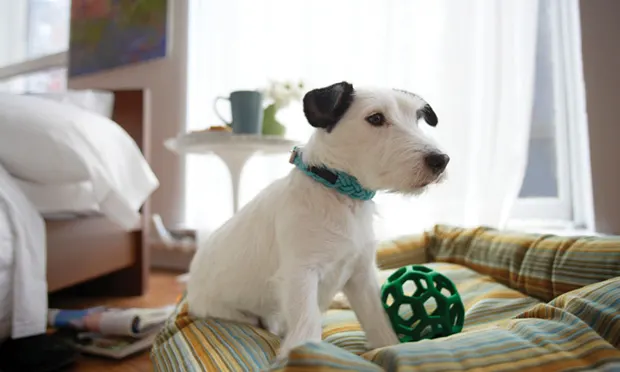Canine Environmental Enrichment

What options can I give clients who are seeking to enhance their dog’s environmental enrichment?
Environmental enrichment (ie, transforming surroundings into experiences via introduction of novelty, opportunities to learn, and occasions to behave according to natural instincts) is an important element in treating many behavioral disorders, including unruly behaviors, cognitive dysfunction syndrome, storm phobia, separation anxiety, compulsive behaviors, and frustration-related behaviors.1,2 Enrichment is also an essential component of care for all pets, including small mammals, reptiles, dogs, cats, and horses, and can have a positive effect on their welfare and well-being.
Related Article: Environmental Enrichment for Dogs & Cats
Enrichment recommendations are generally easy for clients to implement and can be quickly explained by the entire team, making them ideal first-line behavioral recommendations. Clients can begin treatment immediately and can see prompt positive results while waiting for medication and behavior modifications to take effect. In cases of normal but undesirable behaviors, enrichment may be the only recommendation needed.
Enrichment recommendations are generally easy for clients to implement and can be quickly explained by the entire team, making them ideal first-line behavioral recommendations.
Support materials for clients should include an explanation of the patient’s diagnosis, product brochures, written instructions, and a list of sources where recommended products can be purchased. Stocking frequently recommended products makes purchasing these items more convenient for clients and may in turn increase compliance. To lend weight to prescribed enrichment recommendations, the clinician should introduce strategies and products to the client, leaving more detailed explanations to others in the veterinary team.
Specific recommendations should be based on the age, breed, energy level, diagnosis, and the capabilities of the individual owner or family.
Related Article: What Cat Owners Can Learn About Captivity
Dogs will habituate to toys, with a resultant decrease in engagement with each individual toy, and are likely to be most attracted to novel toys.3,4 These characteristics make daily rotation of enrichment items important. Clients should vary the types of items (not just the color or scent) daily.5 A general rule is to provide 3 items per pet per day. Items can be removed and reintroduced every 5 days to maintain novelty.
Exercise
It is widely accepted that exercise is necessary for optimal health in dogs; however, the effect of exercise on serious behavior problems is generally overstated. When possible, an accurate diagnosis should be made to ensure that treatment recommendations have a high likelihood of affecting a positive change.
For dogs to receive the benefits of endogenous reward neurotransmitters (eg, endocannabinoids), they must engage in high-intensity endurance running. Walking does not stimulate the release of these neurotransmitters.6 The challenge is that most owners do not engage in intense exercise with their dogs.
In dogs with separation anxiety, exercise (eg, running at a moderate pace for 3–5 miles) before owner departure rarely affects the anxiety level following owner departure. However, highly energetic or young dogs can greatly benefit from exercise because their behaviors do not stem from anxiety but from increased energy and lack of enrichment.
Instituting enrichment can positively affect most behavior problems, whether they are serious behavioral disorders or simply unruly behaviors.
Enrichment Involving Multiple Categories
Modalities (eg, walks, dog–dog play, interspecies play) can offer clients unique opportunities to enrich their dog’s life in multiple ways simultaneously. Dogs should be allowed to investigate their environment as much as possible (ie, visual, auditory, tactile, gustatory, olfactory stimulation; see Enrichment Strategies). For reactive patients, outside stimulation should be restricted to the backyard until leash reactivity can be treated. Walks should be tolerable, considering overall fitness level and the ambient temperature. Trips in the car, even if just for errands, can offer enrichment as well.
Dog–dog and dog–human play (ie, social enrichment) also allows dogs variable ways in which to be enriched with one activity. There is evidence that these types of play are linked to different motivations and should be considered separate modalities of enrichment.7
Enrichment Strategies
VisualVisual access through a window should be used with caution in dogs that are reactive toward external stimuli (eg, humans, other dogs) because it is likely to result in unruly behavior, such as excessive barking. Less stimulating enrichment (eg, leaving the television on) would be more appropriate for this subset of patients. For dogs without reactivity issues, allowing them visual access through a window can be valuable.
AuditoryLeaving the television or radio on, or playing music or outdoor sounds on a CD can act as auditory enrichment. In addition, dogs can be offered toys that make different sounds.
TactileMany animals have positive responses to tactile stimulation from humans, including petting, brushing, and massage. Owners can easily identify the type of touch their dog appreciates the most: some dogs like their belly scratched while others may find it intimidating. Tactile stimulation also promotes interaction with family members.
OlfactoryToys can be scented by placing them in the family’s dirty clothes basket, using essential oils (it is important to check the toxicity of products before using), or spraying toys with animal scents. Chamomile and lavender can calm dogs, whereas peppermint and rosemary may stimulate them.8 Games in which treats are hidden around the house or hidden in cardboard boxes (eg, nosework) are easy to set up and can keep dogs busy.

GustatoryFood toys (eg, Kong [kongcompany.com], Treat IQ Ball [ourpets.com], Buster Cube [kruuse.com]; Figure 1) are common enrichments for high-energy dogs that can benefit from eating meals out of toys. Food toys are also commonly used in the treatment of storm phobia and separation anxiety to keep the patient occupied during stressful events and to facilitate counterconditioning. In these instances, it is best to engage the dog before the stressful event.
Figure 1. Food toys are widely used as enrichment for high-energy dogs.
Toys can be stuffed with a mixture of low-fat, high-value foods that keep the dog’s interest. Once a dog has become accustomed to eating this way, the toys can be frozen so the dog is engaged for a longer period. To avoid weight gain, the owners should limit giving other food on days when food toys are provided. Food toys can be problematic in multidog households or for dogs inclined toward resource guarding. The best way to handle these scenarios is to separate the dogs.
Closing Remarks
Instituting enrichment can positively affect most behavior problems, whether they are serious behavioral disorders or simply unruly behaviors. The recommendations presented here are easy to implement and explain and represent a sound starting point for developing a successful protocol.
LISA RADOSTA, DVM, DACVB, is owner of Florida Veterinary Behavior Service in Jupiter, Florida. Dr. Radosta’s treatment foci are canine, feline, and avian behavioral problems. She earned her DVM from University of Florida and completed a residency in behavioral medicine at University of Pennsylvania.